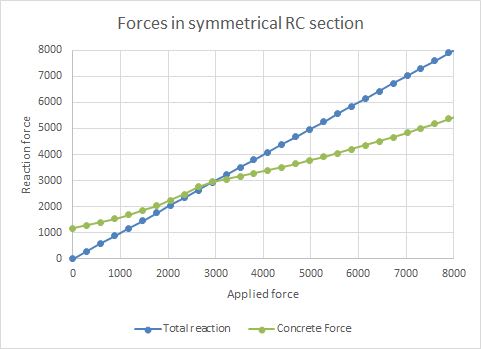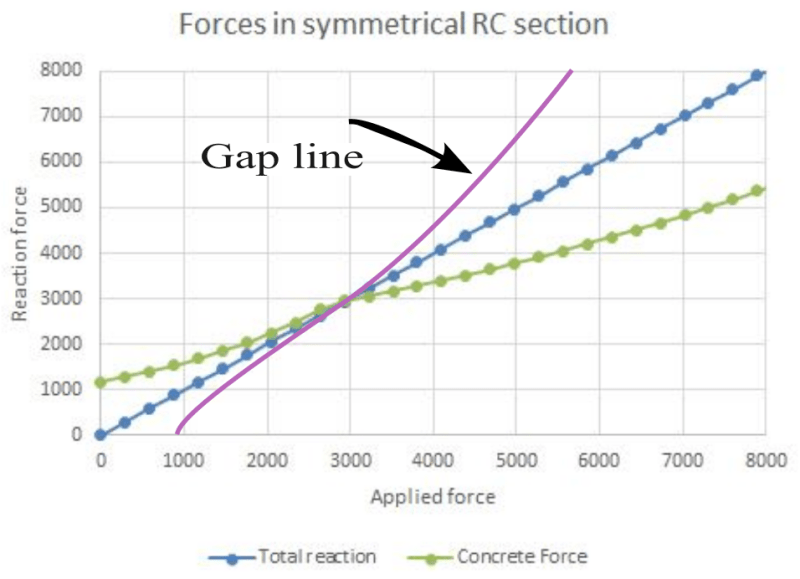Pretty Girl
Structural
- Nov 22, 2022
- 60
I have noticed that the Moment to Axial load interaction diagrams (and or equations) are widely being used to design concrete columns. But I noticed that the principle behind it is just to calculate how much resistive moment (Mc) can be utilised from the axial load and then we are removing that from the main design moment. Although we're reducing the design moment than it actually is, the column is safe as the axial load will act in favour to counter-attack the moment. so it's considered safe. And it will effectively reduce the amount of reinforcement area needed.
example (simplified):
Mrd = Mc + resistance from reinforcement
So, it's considering like 20-30% (or even zero) of the actual moment for design. ( for example If we have the Mrd of 100kNm, then after reduction the Mc, it would be like 50 kNm or even 0 (zero) kNm if the moment resistance provided by axial load (Mc) is big enough to cancel out the actual design moment (Med). But it still will be safe as the axial load will be there to prevent the column from bending.
It may be safe for one or two story buildings.
But I noticed, when you construct the column (in construction phase) for multi story buildings, it's not safe. Imagine you have casted concrete columns for the first floor of the multi story building (say, it has total 20 floors) and you don't have most of the resistive moment from axial load (Mc) yet (because you have not constructed upper floors yet). However, what you will do next is cast the beams or slabs to the columns for that floor, which would apply 100% of the expected moments on the column(s).
However, we never designed that column to have 100% of the moments in the first place, and we expected the axial load to resist the moments. But the problem is the axial load to resist the moment is not there yet. So, this column will definitely fail in the construction phase (after casting the beams and slabs to it). So, why are we using N & M interaction? We can just design the column to the 100% of the moment that it will be encounter. Is it just for the cost savings (to reduce r/f, reduce dimension etc)?
Or is there any valid unavoidable reason that we're taking axial load into account to reduce design moments?
example (simplified):
Mrd = Mc + resistance from reinforcement
So, it's considering like 20-30% (or even zero) of the actual moment for design. ( for example If we have the Mrd of 100kNm, then after reduction the Mc, it would be like 50 kNm or even 0 (zero) kNm if the moment resistance provided by axial load (Mc) is big enough to cancel out the actual design moment (Med). But it still will be safe as the axial load will be there to prevent the column from bending.
It may be safe for one or two story buildings.
But I noticed, when you construct the column (in construction phase) for multi story buildings, it's not safe. Imagine you have casted concrete columns for the first floor of the multi story building (say, it has total 20 floors) and you don't have most of the resistive moment from axial load (Mc) yet (because you have not constructed upper floors yet). However, what you will do next is cast the beams or slabs to the columns for that floor, which would apply 100% of the expected moments on the column(s).
However, we never designed that column to have 100% of the moments in the first place, and we expected the axial load to resist the moments. But the problem is the axial load to resist the moment is not there yet. So, this column will definitely fail in the construction phase (after casting the beams and slabs to it). So, why are we using N & M interaction? We can just design the column to the 100% of the moment that it will be encounter. Is it just for the cost savings (to reduce r/f, reduce dimension etc)?
Or is there any valid unavoidable reason that we're taking axial load into account to reduce design moments?





